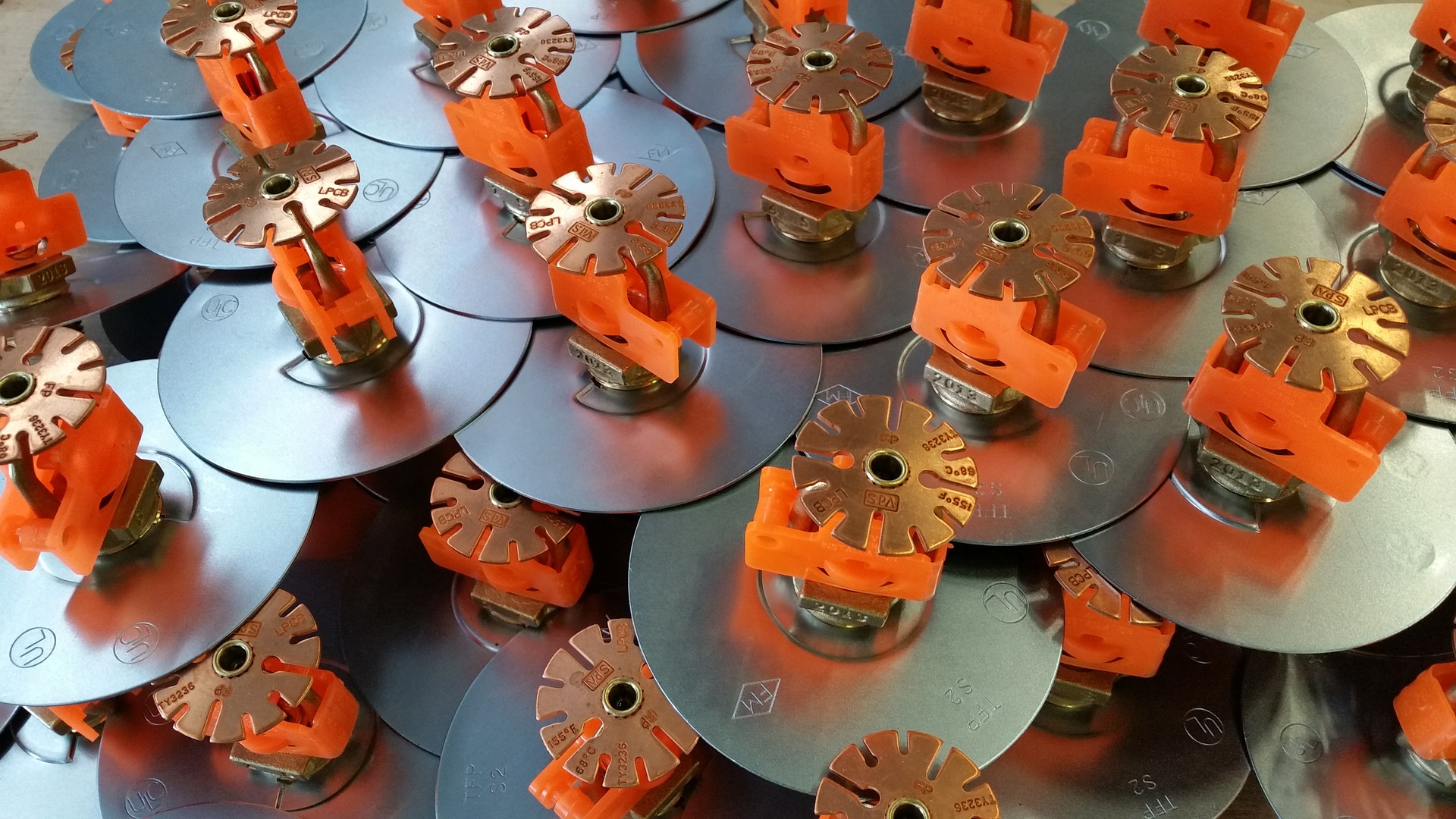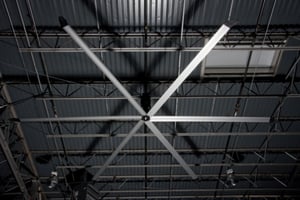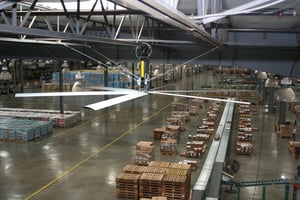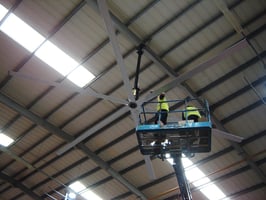Proper installation of your HVLS ceiling fan is essential. It ensures your fan is running at peak...
NFPA 13 Guidelines for Placing HVLS Fans in Sprinkler Protected Buildings
The National Fire Protection Agency (NFPA) is a government organization created to stop fires from causing harm to people and organizations worldwide. In its NFPA 13 document, the NFPA spells out specific standards for how HVLS fan sizing and HVLS fans should be installed in buildings with sprinklers. This blog will examine those standards and why they are crucial to know. But first, what the heck is an HVLS fan?
High Speed Low Volume (HVLS) Fans
HVLS fans were invented by MacroAir in 1998 by our founders, Walt and Eddie Boyd. The University of California Riverside asked them to solve the problem of overheating in a dairy barn. The task was to help produce a cooling effect in the large barn, therefore helping the cows increase milk production. Thus, arose the birth of a HUGE idea for a HUGE fan. HVLS fans have since taken off as an intricate part of a large building’s design. Think about the need to move air in large industrial spaces, or in large commercial or agricultural spaces. They are a necessity in helping with the comfort of people and animals, not a luxury.
.png?width=1080&name=Untitled%20design%20(10).png)
HVLS Fans and Sprinkler Systems
Larger commercial and industrial buildings that use HVLS fans often have alarm systems in place. They help to keep the building safe. This alarm system includes automatic fire sprinklers.
However, the addition of sprinklers can make it hard to choose the right ceiling fans to properly cool a building. This is because they have to be considered during the fan placement and installation process. Do your research and be aware of local and national regulations. This includes allowable sprinkler spacing and maximum fan blade size.
Here is a rundown of what you need to know when looking to install HVLS fans in buildings protected by sprinkler systems.
NFPA Guidelines
The National Fire Protection Agency (NFPA) is a government organization created to stop fires from causing harm to people and organizations worldwide. In its NFPA 13 document, the NFPA spells out standards for how HVLS fans should be installed in buildings with sprinklers. The NFPA 13 says that the installation of a fire sprinkler system is required in all newly constructed commercial buildings 5,000 sq ft or larger. The installation of fire sprinkler systems is also required when there is a renovation adding square feet, creating a total footprint of 12,000 square feet or more to an existing commercial building. Here is additional text from Chapter 11 of the freely-available NFPA 13:
High Volume, Low-Speed (HVLS) Fans
The installation of HVLS fans in buildings equipped with sprinklers, including ESFR sprinklers, shall comply with the following:
- The maximum fan diameter shall be 24 ft (7.3 m).
- The HVLS fan shall be centered approximately between four adjacent sprinklers
- The vertical clearance from the HVLS fan to sprinkler deflector shall be a minimum of 3 ft. (0.9 m).
- All HVLS fans shall be interlocked to shut down immediately upon receiving a water-flow signal from the alarm system in accordance with the requirements of NFPA 72.
Why Do You Need to Be Aware of NFPA 13
1 - Building Layout and Design
You should be aware of NFPA 13 because it impacts the way you layout and design your building or remodel.
- When you purchase an HVLS fan for your building, consider the size of the fan. It is out of NFPA 13 compliance having a fan larger than 24 feet in diameter when you have an alarm system with a suppressive sprinkler present in your building.
- Also, think through the placement of the sprinkler heads and the fan. Center your HVLS fan in between 4 sprinkler heads. When designing and building, some prefer to place the fans first, then design the sprinkler system layout around that. Others prefer to place the sprinklers first, then move the fans.
- Additionally, remember the fan to the sprinkler head must have a minimum vertical clearance of 3 feet. Depending on the size and model, this is usually a non-issue because the clearance requirement for most HVLS fans is at least three feet. Downrods are also available in a variety of lengths. Contact MacroAir's sales representatives for help finding the fan perfect for your warehouse today.
2 - Safety
Sprinklers are an important addition to a building for fire safety. In fact, they save lives. The presence of ceiling fans does not mean you can not have sprinklers present. You just need to be compliant with NFPA 13 for the safety of you, your employees, and your customers. According to an NFPA report, facilities with a hardwired alarm and sprinklers installed have a rate of 1.3 fatalities per 1,000 fires. In comparison, facilities without alarm or sprinkler systems present have a rate of 12.1 fatalities per 1,000 fires. The report also said sprinklers are effective in controlling a fire in 96% of fires where they are present and operating properly.
Is it Safe to Have HVLS Fans with Sprinklers?
The NFPA has implemented these guidelines because of two primary concerns about the way that HVLS fans interact with sprinkler systems:
- Whether or not the sprinkler will be obstructed by a fan nearby.
- How the air distributed by HVLS fans will impact the fires that the sprinklers are attempting to put out.
Multiple studies tested whether or not the presence of HVLS fans would have any impact on sprinklers or the ignition point of a building fire.
HVLS Fans Are Safe with Sprinklers
Two separate studies were conducted on the interaction between HVLS fans and sprinklers during a fire, in 2009 and 2011. Both studies indicate that properly-installed fans pose no threat to sprinkler operation. The study from 2011, performed by Aon Fire Protection Engineering, used the MacroAir MaxAir Whisperfoil XL. Researchers found that Early Suppression Fast Response (ESFR) sprinkler systems adequately protected storage beneath ceilings of up to 40′ even with the presence of HVLS fans.
Schirmer Engineering published this 2009 study. It found that as long as HVLS fans were installed according to NFPA guidelines, there was no particular placement where fans would impact the operation of a sprinkler system. Further, the report was unable to verify that the placement of an HVLS fan directly above the ignition point of a fire would have a negative influence on the spread of a fire.
The Bottom Line
It’s logical to wonder about the impact of HVLS fans on sprinkler systems and fires. Air is an important fuel for the fire, and these fans generate massive airflow. However, as long as your HVLS fan is built and installed according to NFPA 13 guidelines, it will not interfere with sprinkler systems or cause fires to spread.
Visit our website to learn more about the benefits of HVLS fans in large industrial or commercial buildings.


.jpg?width=7952&name=Subaru_Sioux_Falls_Garage_AVD3_4%20(1).jpg)



